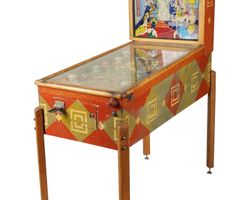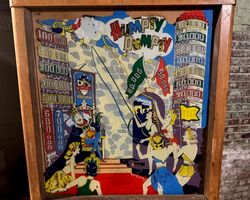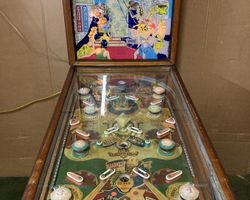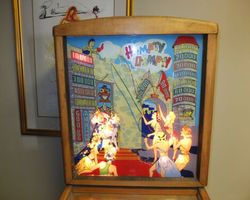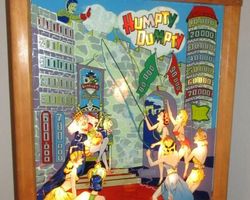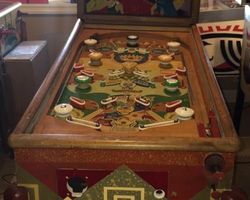Humpty Dumpty
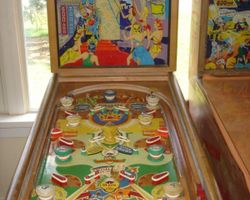
Average Prices: USD $600 to $1,400
Produced: October, 1947
Production Run: 6,500 units
Machine Type: Electro-mechanical
Players: 1
Design by: Harry Mabs
Art by: Roy Parker
The pinball machine "Humpty Dumpty" holds a singular position in the history of electro-mechanical amusement devices. Released by D. Gottlieb & Co. on October 25, 1947, this machine was not merely another addition to the burgeoning arcade landscape; it represented a fundamental redefinition of pinball gameplay. With a production run of 6,500 units, Humpty Dumpty was conceived and designed by Harry Mabs, a Gottlieb employee who provided the concept, animation, and mechanical design. The distinct artwork that brought the machine’s nursery rhyme theme to life was created by Roy Parker.
Prior to Humpty Dumpty, pinball machines primarily relied on passive gameplay, where balls bounced off obstacles with minimal player intervention beyond the initial plunge. While earlier games had featured non-electrical, manually operated bats or "flippers"—such as Ad-Lee Company's 1932 'Double-Shuffle' with eight mechanical flippers, or Smith Manufacturing Company's 1932 'Flipper' countertop game—these were rudimentary and did not offer the responsive player control that would become standard. Harry Mabs's contribution was the invention of the electromechanical flipper, which provided powered, player-controlled bats that could actively influence the ball's trajectory. This innovation was so significant that D. Gottlieb & Co. initially considered naming the game "Flipper" itself, only to discover a prior patent for Smith Manufacturing Company's manual bat game of the same name. The machine's immediate impact was clear; teaser advertisements for "Humpty Dumpty" began appearing in The Billboard in early October 1947, with distributors soon after enthusiastically proclaiming it "the greatest improvement in the history of pin games." This rapid market reception underscored the revolutionary nature of its design.
Signature Features and Design
"Humpty Dumpty" is distinguished by several elements that set it apart. The most significant of these are its six electromechanical flippers. Unlike modern flipper arrangements, these early EM flippers were positioned uniquely across the playfield, acting more as strategic deflectors than powerful launchers. Their primary function was to keep the ball in play and nudge it towards scoring opportunities, offering a nuanced layer of control previously absent from pinball. The playfield also incorporates ten passive bumpers, which are central to scoring, and two kick-out holes that provide bonus points and reset opportunities.
Beyond the groundbreaking mechanics, the machine’s aesthetic appeal plays a vital role in its identity. Roy Parker's artwork captures the whimsical essence of the Humpty Dumpty nursery rhyme, featuring a colorful and engaging design. The playfield and backglass artwork combine vibrant hues with charming depictions of the titular character and his precarious perch. A standout visual feature is the backglass itself, which incorporates a stop-motion light animation depicting Humpty Dumpty's fall. This animated sequence provides a captivating visual reward during gameplay, a sophisticated touch for a machine of its era. An illuminated credit display on the backglass further enhances the presentation, providing clear information to the player. These design elements collectively create an immersive experience that integrates the machine’s theme with its innovative mechanics.
Playfield and Mechanics
The playfield of "Humpty Dumpty" presents a layout that, while simple by contemporary standards, was strategically configured to maximize the impact of its new flipper technology. The most striking aspect is the arrangement of the six flippers. Rather than being confined to the lower apron, these flippers are distributed across the lower and mid-sections of the playfield, allowing for defensive saves and directional nudges towards specific targets. The upper portion of the playfield is dominated by ten passive bumpers. These stationary posts are designed to bounce the ball unpredictably, generating points as the ball ricochets off them. Two kick-out holes serve as key objectives, offering significant bonus points when the ball lands within them.
The design philosophy behind this layout was to create a dynamic environment where the newly introduced flippers could interact with a field of passive elements. The flow of the game is characterized by the ball descending through the array of bumpers, with players using the flippers to either save the ball from draining or direct it towards the kick-out holes. Roy Parker’s artwork on the playfield provides a delightful backdrop to this action, with clear scoring lanes and targets integrated seamlessly into the colorful Humpty Dumpty theme. The lighting, particularly the backglass animation, complements the playfield, drawing the player’s attention and signaling significant moments in the game. This thoughtful integration of mechanics and visuals ensured that "Humpty Dumpty" was not just a technological demonstration but a coherent and engaging pinball experience.
Gameplay Dynamics
The gameplay of "Humpty Dumpty" is a testament to the elegant simplicity that defined early electro-mechanical machines, while simultaneously introducing a fundamental shift in player interaction. The scoring system is straightforward: points are primarily accumulated by hitting the numerous passive bumpers scattered across the playfield. Each successful contact adds to the player's score, encouraging the ball to stay in motion within the upper and mid-playfield areas. The two kick-out holes serve as primary objectives, offering substantial bonus points upon activation, providing a clear goal for players aiming for high scores.
The unique challenge of "Humpty Dumpty" lies in mastering its early flipper technology. Unlike modern powerful flippers, those on this machine operate with a more subdued force, often functioning as precision diverters rather than long-range launchers. Players develop strategies centered on subtle nudges, calculated deflections, and careful timing to maneuver the ball through the dense field of bumpers and towards the rewarding kick-out holes. The game's progression is largely about managing the ball's descent and maximizing bumper hits and kick-out hole captures before the ball inevitably drains. The stop-motion animation on the backglass, depicting Humpty Dumpty falling, serves as a visual highlight, providing a captivating focal point beyond the playfield action and marking moments of triumph or progression within the game's simple yet captivating loop. Despite its relative simplicity in rules compared to complex modern machines, the interactive nature provided by the flippers created a "one more game" appeal, inviting players to continually refine their control and strategy.
Reception and Legacy
"Humpty Dumpty" holds an esteemed position within the pinball community, primarily lauded for its historical significance. Many enthusiasts consider it a landmark machine, essential to understanding the evolution of the genre. Its introduction of the electromechanical flipper fundamentally altered pinball, transitioning it from a game of chance and passive ricochets to one requiring player skill and direct ball manipulation. This innovation is consistently recognized as the "greatest improvement" in pinball, an assessment echoed by industry observers and players alike since its 1947 release.
The machine’s strengths often highlighted include its surprisingly enjoyable gameplay, with many finding it genuinely fun and possessing a strong nostalgic draw. The distinctive artwork by Roy Parker is frequently praised for its charming, colorful design, with the backglass animation of Humpty Dumpty’s fall being a particular point of appreciation. Despite its age and the inherent simplicity of early EM games, some players find the gameplay challenging, requiring a unique skill set to navigate the passive bumpers and utilize the early flippers effectively, especially when aiming for the rewarding kick-out hole bonus.
However, "Humpty Dumpty" is not without its acknowledged limitations. Its gameplay depth is shallow when compared to more recent pinball machines, featuring simpler rules and objectives. The flippers, while revolutionary for their time, are often noted as being less powerful and more akin to "diverters" than the robust flippers of later designs. This characteristic, stemming directly from its pioneering nature, can lead to a more repetitive shot experience for some players. As such, while universally respected for its historical context, some players, particularly those accustomed to modern machines, may find the gameplay less engaging. Nevertheless, the machine’s overall sentiment remains overwhelmingly positive, largely due to its foundational contribution to pinball. Its influence is undeniable; "Humpty Dumpty" paved the way for every subsequent pinball machine, establishing the flipper as the core interactive element and forever changing the trajectory of pinball design.
Sponsored Links
 Ebay Listings
Ebay Listings
 Auction Results
Auction Results
| Cost | Location | Date |
|---|---|---|
| USD $600 |  California, United States California, United States |
26 June, 2025 |
| GBP £899 |  London, United Kingdom London, United Kingdom |
14 April, 2025 |
| USD $1,650 |  Ohio, United States Ohio, United States |
12 September, 2024 |
| USD $710 |  California, United States California, United States |
17 March, 2020 |
| USD $2,400 |  Nebraska, United States Nebraska, United States |
14 January, 2020 |
| USD $1,000 |  Illinois, United States Illinois, United States |
21 June, 2018 |
| USD $1,200 |  Massachusetts, United States Massachusetts, United States |
13 June, 2017 |
| USD $1,100 |  California, United States California, United States |
11 October, 2016 |
| USD $2,500 |  California, United States California, United States |
28 May, 2016 |
| USD $534 |  California, United States California, United States |
24 November, 2015 |


Private Policy · Search Website · Contact Us
As an eBay Partner, we may earn a commission from qualifying purchases made through links on this site, at no additional cost to you.
All trademarks and copyrighted materials remain property of their respective owners. All other content copyright 2007 - 2025 Pinpedia.

